About the Project
With a growing share of intermittent renewable energy sources grid stability can be maintained, and flexibility enhanced, by applying pumped hydropower energy storage. ALPHEUS will improve reversible pump/turbine (RPT) technology and adjacent civil structures needed to make pumped hydro storage economically viable in shallow seas and coastal environments with flat topography.
Three promising technologies will be considered:
- Shaft-driven variable-speed contra-rotating propeller RPT – avoiding guide vanes in a two-way device improves overall efficiency;
- Rim-driven variable-speed contra-rotating propeller RPT – rim driven configuration avoids the complexity of a shaft assembly, decreasing noise, vibrations, switching time, and maintenance costs;
- Positive displacement RPT – fish friendly and seawater-robust, low cost technology.
ALPHEUS plans stepwise development, starting by validating current assumptions in the lab and optimizing efficiency with numerical simulations. Based on results, two of these technologies will be chosen and functionality will be demonstrated for working models under realistic circumstances. Finally, a reasoned and quantified assessment of these two technologies will be delivered for further development into full scale prototype. Combining current state-of-the-art and expertise of the partners ALPHEUS expects to reach round-trip RPT efficiency of 0.7 to 0.8. Fatigue resistance of mechanical and civil installations will be addressed, which occur with switching between pumping and turbining modes within 90-120 seconds. ALPHEUS will address environmental aspects, including fish friendliness, scenery and land use, juxtaposed with the ability of decentralized pumped hydro storage to stabilize the grid over a range of timescales and therefore allow higher penetration of intermittent renewable energy supplies. This will result in a methodology for assessing potential sites for pumped low-head and ultra-low head energy storage.
Introduction
European goals for reducing greenhouse gas emissions require the increase of renewable energies used in the electric grid. Nowadays the most developed renewable energy technologies are wind, solar and hydraulic power stations. Wind and solar energy capacity has been rapidly increasing in the last years. However, the natural unpredictability of these energy sources calls for the addition of extra features to the grid.
Consider a winter windless day: the wind and solar energy stations cannot produce energy. Currently, when this happens, non-renewable energy sources are used to produce electricity. To avoid the use of the polluting energy sources, there are two main alternatives (at present):
- Increasing the grid’s transmission capacity: consider the previously-mentioned winter windless day. Probably in another region there is an excess of sun or wind energy that surpasses the consumption of that region. In that case, with an increase of the electric transmission lines, the electricity that is not locally consumed, can be transported to the places it is needed.
- Store energy: this allows to locally store excess renewable energy production, for instance during a summer windy day. Later, for instance a winter windless day, this energy can be converted into electricity.
Mainly, increasing the transmission capacity is time-consuming and expensive compared to energy storage. Energy storage is already being performed in a grid-scale, mainly by pumped hydro storage stations. When there is an excess of renewable energy being produced, this excess is used to pump water from a reservoir to a more elevated one (around 300 – 600 m of elevation difference). When electricity is needed, the water is drained through a turbine back to the lower reservoir, producing electricity in the process. With enough storage capacity, the turbines would provide electricity during the winter windless days of the previous example.
However, this kind of technology is not feasible in the low-lying countries such as the Netherlands, Belgium and Northern Germany. A possible solution would be to research whether pumped hydro stations can be installed in the North Sea. The difference with the previously mentioned stations is that the elevation difference between reservoirs is much lower (around 20 m). This concept is very innovative, it has never been built and less than 10 plans have been developed regarding this technology. The ALPHEUS project will look at the feasibility of low-head pumped hydro storage stations in the North Sea. Important aspects of the research are new pump-turbine designs, new power electronics, design of new and innovative powerhouses, law considerations and of course, sustainability and affection to the local flora and fauna.

Introduction
Europe wants to become the first climate-neutral continent in the world by 2050. Already by 2030, the European Union plans to reduce greenhouse gas emissions at least 55% compared to 1990 levels. One of the targets defined to achieve this is to decarbonize the energy sector, i.e. introducing more renewable energy sources into the European grid. During the period 2008 – 2018, wind energy, solar energy, and solid biofuels technologies have rapidly grown, and wind power became the most important renewable source of energy in Europe1. Currently, renewable energy in the European grid is produced by wind power (36%), hydropower (33%), solar power (12%), solid biofuels (9%), and other renewables (9%).
However, as shown in this document, because of the natural unpredictability of the renewable energy sources (e.g. wind, solar) zero greenhouse gas emissions cannot be achieved by just increasing the amount of these energy sources. The inclusion of more renewable energy generation stations must be accompanied by new technologies to store energy and/or to distribute it between production sites and consumption hubs. To understand this, first this document presents you a summary of how the energy system works. Then, we will see the challenges that arise when increasing the renewable energy stations (e.g. wind and solar stations). Finally, we focus on how energy storage could help to solve these challenges, particularly the pumped hydro storage technology.
Energy System
The figure below shows the network used to generate and transport electricity to our houses, workplace, favorite stadium, etc. Electricity is produced on demand at the power stations (non-renewable sources such as: coal, gas, petroleum… or renewable sources such as: wind, solar, hydropower…) and then transported through a complex network of transformers and transmission lines to our homes. Electricity must be produced and used to power an electronic device. It cannot be stored (Think about a bike’s dynamo, without a battery, when the bike is not running there is no light). Thus, the produced electricity must follow the actual demand at each moment of the day.
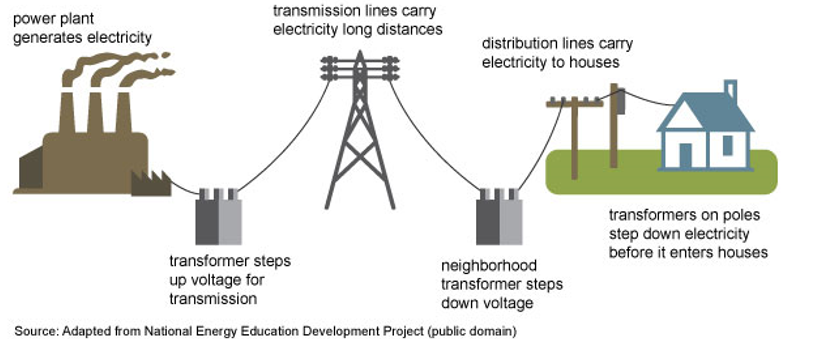
Source: https://www.eia.gov/energyexplained/electricity/delivery-to-consumers.php
Figures 2, 3 and 4 show this correlation between electricity generation (colored areas) and consumption (red line) during three different past days, taking Germany as an example. Comparing Figures 2 and 3, we can observe that during summer (Fig 2) there is a peak in energy use at the warmer hours (from 10:00 to 16:00) whereas in winter the energy use is more extended during the working hours (from 7:00 to 18:00). Additionally, we can see that for both days, the wind was blowing and thus a large share of electricity was produced with onshore wind power stations. During the summer month the available solar energy is much larger, which allowed for a lower use of fossil hard coal, brown coal and gas respecting the winter months.
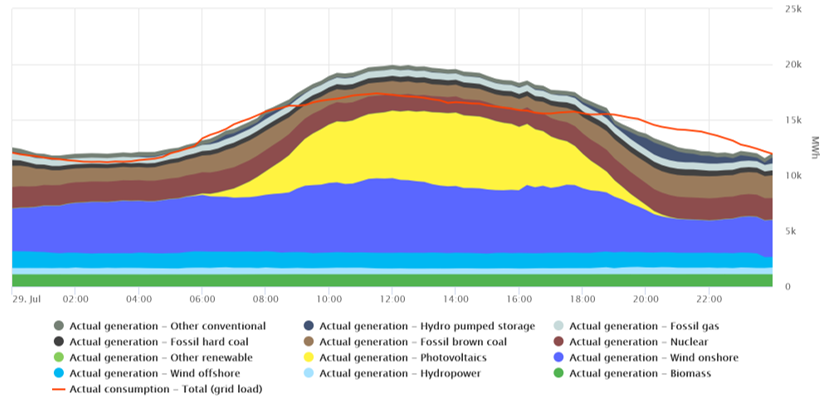
Source: https://www.smard.de/en

Source: https://www.smard.de/en
This is even more clear when comparing Figures 2 and 4, Figure 4 represents a winter day in which the wind was not blowing. Therefore, there was no opportunity to generate much wind energy and as a result, we can see that the most of the energy generated comes from coal and gas. This shows that just having electricity generation stations that are powered with wind and solar does not ensure to have a constant share of renewable energy throughout the year. When there is not enough wind or sun available, electricity cannot be produced from these sources. The power stations are still there, but there is simply no way of obtaining electricity from them. Thus, to meet the European goal of being a climate-neutral continent by 2050, we need a way to ensure the renewable energy supply over the year. As we will see below, energy storage and increasing the energy transmission lines can help cope with this issue.

Source: https://www.smard.de/en
Increase of Renewable Energy within the Grid: Curtailment
The addition of large amounts of wind and solar energy stations to the grid, due to its unpredictable nature, may cause some issues in the electric grid. At times of large wind and solar energy production, the system operators may have to accept less wind and solar than it is available2. This is because the wind turbines and solar panels would be able to produce more electricity than the consumed one. But we cannot produce energy that cannot be used. Thus, either the wind turbines or solar panels (or both) stop working. This measure is called curtailment; a pause in renewable energy production. The EU’s Twenties project showed that large-scale offshore wind development could increase wind curtailment (the more wind capacity we install the larger the probability that during a windy day, some or several windmills must stop working because its electricity cannot be used).
Solving Curtailment
Lack of transmission capacity (i.e. capacity to transport the generated electricity via the grid) is the main factor by which curtailment occurs because when there is an excess of wind, the excess energy cannot be transported to other areas where it may be used3. Many approaches can be used to increase the transmission capacity of the grid, but to expand the existing transmission network is expensive and time-consuming4. An alternative is energy storage. Instead of taking the energy somewhere else, it can be locally stored for later use5. However, we already mentioned that electricity itself cannot be stored, we need to transform this electricity into another kind of energy (if the reader is interested, some examples are potential energy: pumped hydro storage, kinetic energy: flywheel, chemical energy: batteries).
Energy Storage
There are several energy storage methods that the reader is invited to check by publicly available literature. Here, because of the ALPHEUS project’s focus and to keep it simple, we will focus on the pumped hydro storage (PHS) technology (See Figure 5). PHS is already a proven technology in mountainous regions. This technology requires two different reservoirs (low and upper reservoirs) at different elevations. When there is excess electricity in the grid, it is used to pump water from a lower reservoir to an upper one (thus electricity is converted into potential energy). Whenever electricity is needed again, the water is drained from the upper reservoir to the lower reservoir and thus electricity is produced by a turbine (potential energy is converted into electricity).
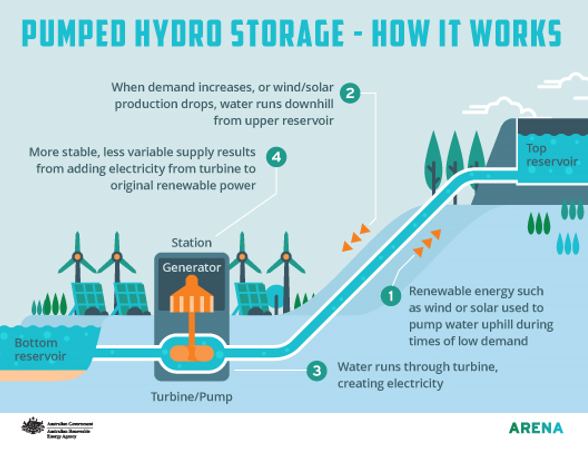
Source: Australian Renewable Energy Agency (ARENA, 2017).
In Figure 6 we can see how the use of pumped hydro storage can help storing energy during times of high renewable energy generation (use of electricity to pump water to an elevated basin). Later, when the renewable energy generation is not enough to supply the demand, the initially stored energy can be added to the grid (the water in the elevated basin is released through the turbine, which generates electricity).

A study performed by Chen et al (2009)6 showed that pumped hydro storage technology ranks to be one of the cheapest energy storage technologies in terms of costs per kWh of electricity produced. Besides, its large storing capacity makes the system attractive for grid-scale energy storage. However, this technology requires having a large head difference between both basins, usually achieved by the natural elevation difference provided by mountains. Thus, the use of this technology is not possible in low-lying countries such as The Netherlands, Belgium or Northern Germany. For that reason, the ALPHEUS project was developed. This project studies the feasibility of pumped hydro storage in the North Sea.
Besides, the pump-turbine technology systems used in high-head PHS cannot be used in low-head PHS because of the different physics involved. In short, in high-head PHS the energy is obtained from the large head difference between the two water basins. In low-head PHS the energy is obtained from increasing the mass of water that passes through the turbines. Besides, the equipment used in high-head PHS operates in fresh water and in low-head PHS it should operate with seawater. Figure 7 shows a cross-section of a low-head PHS design. Notice that now we do not have a lower and an upper basin, but the sea (acting as an upper reservoir) and the enclosed reservoir (acting as a lower reservoir). In times of excess electricity, pumps take the water towards the sea and during the contrary times, seawater is drained through the turbine into the enclosed reservoir.
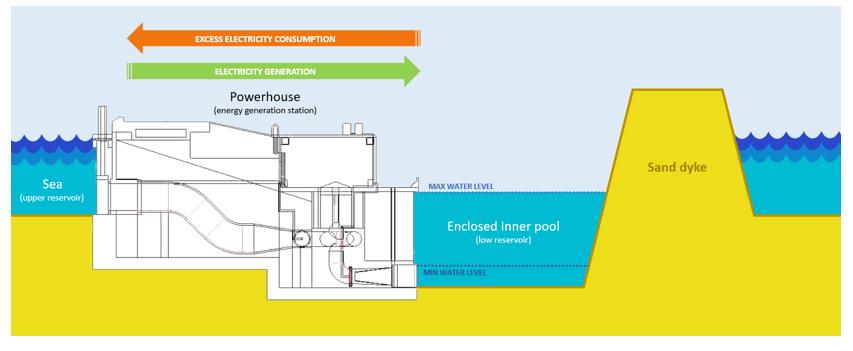
Low-head PHS technology is a very innovative concept which grows out of two existing technologies: high-head PHS and seawater tidal energy generation. The working methods are similar to those of high-head PHS but instead of obtaining energy from a large head difference, it is obtained from the large amount of water that passes through the pump-turbines. From tidal energy stations we can learn how to operate mechanical and electric equipment in a marine environment.
The only high-head PHS station that ever operated with seawater was the Okinawa Yanburu PHS station in Japan. The Okinawa PHS station used a 142 m cliff to provide the head difference between the lower and upper basin. This station already provides some experience when operating pumped hydro equipment in seawater.
Respecting low-head PHS, only few plans have been developed so far, yet none have been constructed. In 1981, the Dutch engineer Luc Lievense published a proposal for an energy storage lake in the Markemeer (a large lake in the Netherlands). His plan later developed into various alternatives. The final plan ended up in a 70 m high-dyke alternative at the Brouwersdam (Dutch storm surge barrier). Following up the Lievense plan, in 2007 KEMA consulting and Lievense BV developed a new energy island design (see Figure 8). The design included an excavated 40 m deep basin and the inner lake was used as a low reservoir and the sea as the upper basin. This ‘bathtub’ concept was named a ‘valmeer’, with the benefit of lower dykes avoiding safety concerns related to dyke breaching; a weakness the 1981 plan had.
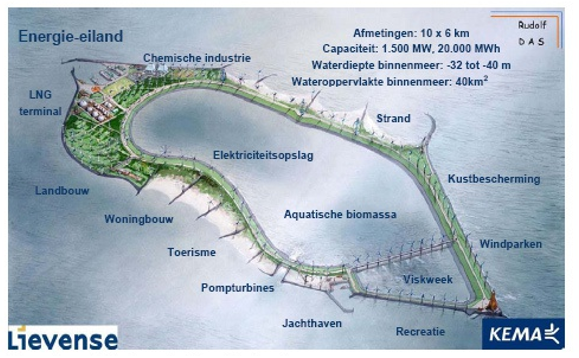
Source: https://tweakers.net/reviews/7696/6/veelbelovende-technologie-voor-de-emissieloze-economie-stuwmeren.html
From these valmeer concept, some other projects have been designed such as TIESI (Taiwan Integrated Energy Storage Island) in 2014. In 2018, the Belgian Federal Government financed the iLand project which involves a low-head PHS. The plan’s execution has been delayed due to permitting issues. Since this would be the first cross-border hybrid storage project of its kind, the negotiations with many different authorities is delaying the execution of this plan more than expected. Additionally, the regulatory framework respecting storage currently carries a rather large degree of uncertainty.
Other low-head PHS schemes such as Delta21 can be integrated in the flood protection system of a country. Delta21 is an integrated plan for flood safety and energy storage in the area of the Haringvliet (South Holland, The Netherlands). In daily conditions the pump-turbine station works to store energy, whereas during periods of large storm surges and large river discharges, the pumping station will be used to get rid of the river discharge that would otherwise accumulate upstream of the storm surge. Which could, in turn, raise the water level within the storm surge barrier and flood the surrounding areas.
Conclusion
As a recap, ALPHEUS aims to discover whether low-head PHS is a feasible technology at the North Sea to cope with the problem of large-scale renewable energy storage. Following past advances and designs, ALPHEUS will design new structures, reversible pump-turbines and electrical systems necessary to make the low-head PHS feasible at the North Sea. Special attention to risk, economics and sustainability will be paid. Besides, stakeholder consultations will be developed to ensure that these structures are socially accepted and the requirements from stakeholders are considered for design of such structures. Effectively bringing development to both coastal communities and technological companies.
The ALPHEUS project classifies its stakeholders in three different groups:
- Government authorities/policy and decision makers on spatial planning and permits
- Commercial parties interested in the site (energy distribution company…)
- Local communities and their interest groups (fishery, nature protection, recreation…)
In general, all the stakeholders will be asked to provide some information about their familiarity with PHS technology to analyze if this is a known technology. Besides, the stakeholders will be able to give their opinion about the project: if it makes sense ecologically, what other options they consider useful regarding energy storage, what are their concerns when thinking about low-head PHS in the North Sea, etc. After these general questions, the questions are different for each of the three above-mentioned stakeholder groups.
- The “Government authorities/policy and decision makers on spatial planning and permits” group will be able to provide information on possible necessary new regulation for the prospect implementation of a low-head PHS station in the North Sea.
- The “Commercial parties interested in the site (energy distribution company etc)” group will be able to provide feedback on their interest/capabilities to construct, manufacture, make further designs after the ALPHEUS project is developed. Their experience in similar projects (conventional PHS, hydropower in general, marine works, grid works, design/manufacture of turbomachinery, etc) will also be analyzed via the questionnaire to understand which stakeholders could be capable of following up the ALPHEUS project work (of course, in case it is interesting for them).
- The “Local communities and their interest groups (fishery, nature protection, recreation etc.)” will mainly give feedback on their requirements for location selection (distance from coast, affection to landscape) which then the ALPHEUS project will turn into design requirements.
Finally, each stakeholder will choose if they want to still be a stakeholder for ALPHEUS and how to be a stakeholder: just obtaining information (webpage, newsletter), participating in stakeholder meetings, helping to provide information in other similar questionnaires in the future…

